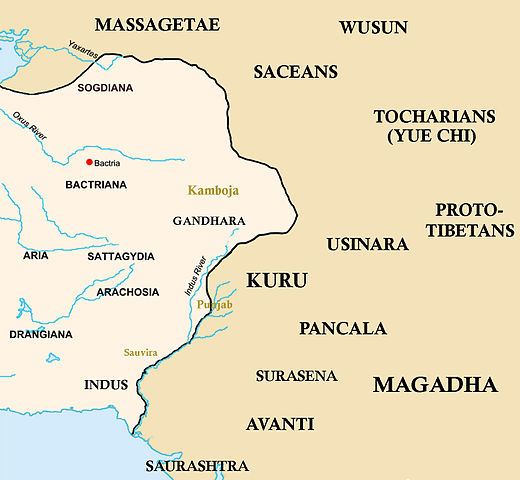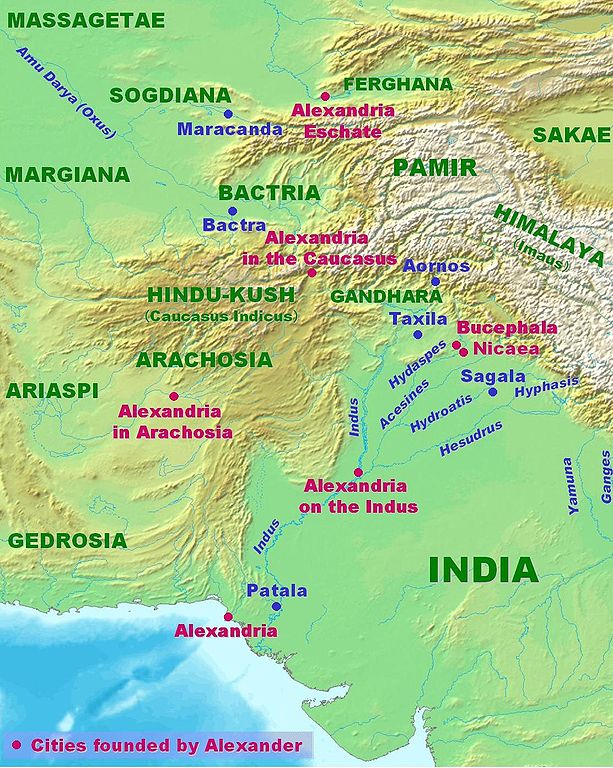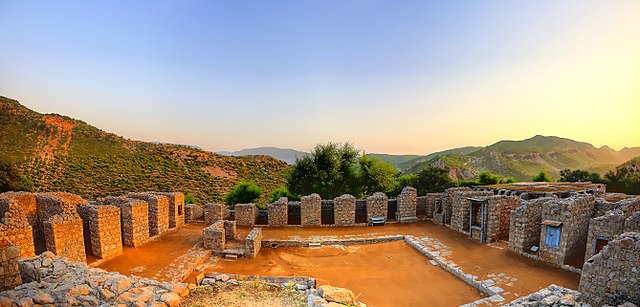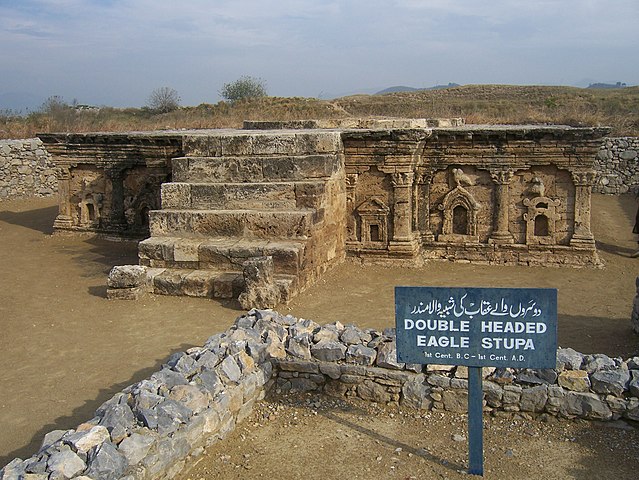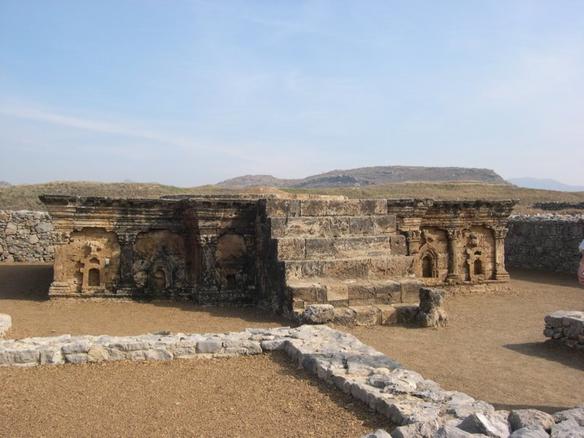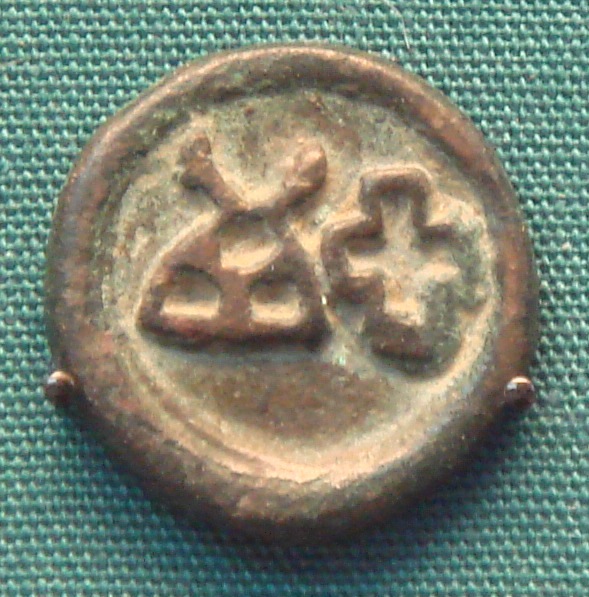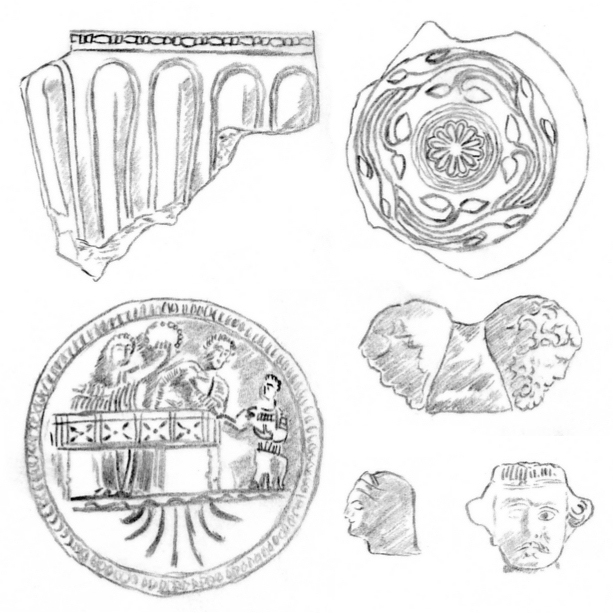
| TAKSHASHILA (TAXILA)
Taxila or Takshashila Country
: Pakistan
Taxila or Takshashila (Sanskrit: TakSasila; Pali: Takkasila; Prakrit: Takkhasila; Ancient Greek: Táxila), is a city in Punjab, Pakistan. Located in the Taxila Tehsil of Rawalpindi District, it lies approximately 25 kilometres (16 mi) northwest of the Islamabad–Rawalpindi metropolitan area and is just south of Haripur District in Khyber Pakhtunkhwa.
Old Taxila was an important city of ancient India, situated on the eastern shore of the Indus River—the pivotal junction of the Indian subcontinent and Central Asia; it was founded around 1000 BCE. Some ruins at Taxila date to the time of the Achaemenid Persian Empire in the 6th century BCE, followed successively by the Maurya Empire, the Indo-Greek Kingdom, the Indo-Scythians, and the Kushan Empire. Owing to its strategic location, Taxila has changed hands many times over the centuries, with many polities vying for its control. When the great ancient trade routes connecting these regions ceased to be important, the city sank into insignificance and was finally destroyed by the nomadic Central Asian Hunas in the 5th century. In the mid-19th century, British archaeologist Alexander Cunningham rediscovered the ancient city's ruins. In 1980, Taxila was declared a World Heritage Site by UNESCO.
By some accounts, the university in ancient Taxila is considered to be one of the earliest universities in the world. Other scholars do not consider it to have been a university in the modern sense, in that the teachers living there may not have had official membership of particular colleges, and there did not seem to have existed purpose-built lecture halls and residential quarters in Taxila, in contrast to the later university of Nalanda in Magadh (Bihar, India). In a 2010 report, the Global Heritage Fund identified Taxila as one of 12 worldwide sites that "on the verge" of irreparable loss and damage, citing insufficient management, development pressure, looting, and armed conflict as primary threats. However, significant preservation efforts have been carried out by the Pakistani government since then, which has resulted in the site being declared as "well-preserved" by different international publications. Because of the extensive preservation efforts and upkeep, the site is a popular tourist spot, attracting up to one million tourists every year.
Etymology :
The
name for the city of Taxila (Pali Brahmi: Takhkhasila), as it appears
on the Heliodorus Pillar inscription, circa 100 BCE.
The city's modern name, however, is derived from the ancient Greek rendering noted in Ptolemy's Geography. The Greek-language transcription of Taxila became universally favoured over time, and both the Sanskrit and Pali names fell out of use.
Faxian, a Chinese Buddhist pilgrim who visited the city via the Silk Road, had given its name's meaning as "cut-off head". With the help of a Jatak, he had interpreted it to be the place where Buddha—in his previous birth as Pusa or Chandaprabha—cut off his head to feed a hungry lion. This tradition still persists with the area in front of Sirkap (also meaning "cut-off head"), which was known in the 19th century as Babur Khana ('House of Tiger'), alluding to the place where Buddh offered his head. In addition, a hill range to south of the Taxila Valley is called Margala (lit. 'cut-off throat').
In
traditional sources :
One of the earliest mentions of Taxila is in Panini's Ashthadhyayi, a Sanskrit grammar treatise dated to the 5th to 4th centuries BCE.
Much of the Hindu epic, the Mahabharat, is a conversation between Vaishampayan (a pupil of the sage, Vyas) and King Janamejay. It is traditionally believed that the story was first recited by Vaishampayan at the behest of Vyasa during the snake sacrifice performed by Janamejay at Takshashila. The audience also included Ugrashravas, an itinerant bard, who would later recite the story to a group of priests at an ashram in the Naimisharanya Forest from where the story was further disseminated. The Kuru Kingdom's heir, Parikshit (grandson of Arjun) is said to have been enthroned at Takshashila.
The Ramayan describes Takshashila as a magnificent city famed for its wealth which was founded by Bharat, the younger brother of Ram. Bharat, who also founded nearby Pushkalavati, installed his two sons, Taksh and Pushkal, as the rulers of the two cities.
In the Buddhist Jataks, Taxila is described as the capital of the kingdom of Gandhar and a great centre of learning with world-famous teachers. The Takkasila Jatak, more commonly known as the Telapatta Jatak, tells the tale of a prince of Benares who is told that he would become the king of Takkasila if he could reach the city within seven days without falling prey to the yakshinis who waylaid travellers in the forest. According to the Dipavamsa, one of Taxila's early kings was a Kshatriya named Dipankar who was succeeded by twelve sons and grandsons. Kuñjakarna, mentioned in the Avadanakalpalat, is another king associated with the city.
In the Jain tradition, it is said that Rishabh, the first of the Tirthankars, visited Taxila millions of years ago. His footprints were subsequently consecrated by Bahubali who erected a throne and a dharmachakra ('wheel of the law') over them several miles in height and circumference.
History
:
The earliest settled occupation in Taxila Valley was found at Sarai Khola, located 2 km to the south-west of Taxila Museum, where three radiocarbon dates from Period I suggest the site was first occupied between the late 4th and early 3rd millennium BCE, with deposits of polished stone celts, chert blades and a distinctive type of highly burnished pottery that shows clear signs of the use of woven baskets in the manufacturing process and the application of a slurry to the exterior surface. Periods IA and II at Sarai Khol seem to show continuity from Period I, with the appearance of red burnished wares. However, Kot Diji-style wares were found in greater numbers, and the Kot Diji-style forms show signs of having been wheel-thrown, marking a clear technological change from the Period I material. Seven radiocarbon dates were also taken from the earlier and later Period II/Kot Diji, and seem to show this phase dates from the mid-late 3rd to early 2nd millennium BCE.
Later on, the first major settlement at Taxila, in Hathial mound, was established around 1000 BCE. By 900 BCE, the city was already involved in regional commerce, as discovered pottery shards reveal trading ties between the city and Pu?kalavati.
Later, Taxila was inhabited at Bhir Mound, dated to some time around the period 800-525 BCE with these early layers bearing grooved red burnished ware.
Eastern border of the Achaemenid Empire
Achaemenid :
Taxila was sometimes ruled as part of the Gandhar kingdom (whose capital was Pushkalavati), particularly after the Achaemenid period, but Taxila sometimes formed its own independent district or city-state.
Hellenistic :
During his invasion of the Indus Valley, Alexander the Great was able to gain control of Taxila in 326 BCE without a battle, as the city was surrendered by its ruler, king Omphis (Ambhi). Greek historians accompanying Alexander described Taxila as "wealthy, prosperous, and well governed". Arrian writes that Alexander was welcomed by the citizens of the city, and he offered sacrifices and celebrated a gymnastic and equestrian contest there.
Mauryan
:
Taxila was founded in a strategic location along the ancient "Royal Highway" that connected the Mauryan capital at Pataliputra in Bihar, with ancient Peshawar, Puhkalavati, and onwards towards Central Asia via Kashmir, Bactria, and Kapis. Taxila thus changed hands many times over the centuries, with many empires vying for its control.
Indo-Greek
:
The last Greek king of Taxila was overthrown by the Indo-Scythian chief Maues around 90 BCE.Gondophares, founder of the Indo-Parthian Kingdom, conquered Taxila around 20 BCE, and made Taxila his capital. According to early Christian legend, Thomas the Apostle visited Gondophares IV around 46 CE, possibly at Taxila given that city was Gondophares' capital city.
Kushan
:
Gupta
:
Taxila's university remained in existence during the travels of Chinese pilgrim Faxian, who visited Taxila around 400 CE. He wrote that Taxila's name translated as "the Severed Head", and was the site of a story in the life of Buddha "where he gave his head to a man".
Decline
:
The White Huns and Alchon Huns swept over Gandhar and Punjab around 470 CE, causing widespread devastation and destruction of Taxila's famous Buddhist monasteries and stupas, a blow from which the city would never recover. From 500 CE to 540 CE, the city languished after falling under the control of the Hunnic Empire ruled by Mihirakula. A patron of Hindu Shaivism, Mihirakul presided over some destruction of Buddhist sites and monasteries across northwestern regions of the Indian subcontinent.
Xuanzang visited India between 629 and 645 CE. Taxila which was desolate and half-ruined was visited by him in 630 CE, and found most of its sangharamas still ruined and desolate. Only a few monks remained there. He adds that the kingdom had become a dependency of Kashmir with the local leaders fighting amongst themselves for power. He noted that it had some time previously been a subject of Kapis. By the ninth century, it became a dependency of the Kabul Shahis. The Turki Shahi dynasty of Kabul was replaced by the Hindu Shahi dynasty which was overthrown by Mahmud of Ghazni with the defeat of Trilochanpal.
Al-Usaifan's king during the reign of Al-Mu'tasim is said to have converted to Islam by Al-Biladhuri and abandoned his old faith due to the death of his son despite having priests of a temple pray for his recovery. Said to be located between Kashmir, Multan and Kabul, al-Usaifan is identified with kingdom of Taxila by some authors.
Centre of learning :
A view over the ruins of Sirkap By some accounts, Taxila was considered to be one of the earliest (or the earliest) universities in the world. Others do not consider it a university in the modern sense, in that the teachers living there may not have had official membership of particular colleges, and there did not seem to have existed purpose-built lecture halls and residential quarters in Taxila, in contrast to the later Nalanda university in eastern India.
Taxila became a noted centre of learning (including the religious teachings of Buddhism) at least several centuries BCE, and continued to attract students from around the old world until the destruction of the city in the 5th century. It has been suggested that at its height, Taxila exerted a sort of "intellectual suzerainty" over other centres of learning in India and its primary concern was not with elementary, but higher education. Generally, a student entered Taxila at the age of sixteen. The ancient and the most revered scriptures, and the Eighteen Silpas or Arts, which included skills such as archery, hunting, and elephant lore, were taught, in addition to its law school, medical school, and school of military science. Students came to Taxila from far-off places such as Kashi, Kosala and Magadha, in spite of the long and arduous journey they had to undergo, on account of the excellence of the learned teachers there, all recognised as authorities on their respective subjects.
Notable
students and teachers :
The institution is significant in Buddhist tradition since it is believed that the Mahayan branch of Buddhism took shape there.] Jivak, the court physician of the Magadh emperor Bimbisar who once cured the Buddh, and the Buddhism-supporting ruler of Koshal, Prasenajit, are some important personalities mentioned in Pali texts who studied at Taxila.
No external authorities like kings or local leaders subjected the scholastic activities at Taxila to their control. Each teacher formed his own institution, enjoying complete autonomy in work, teaching as many students as he liked and teaching subjects he liked without conforming to any centralised syllabus. Study terminated when the teacher was satisfied with the student's level of achievement. In general, specialisation in a subject took around eight years, though this could be lengthened or shortened in accordance with the intellectual abilities and dedication of the student in question. In most cases the "schools" were located within the teachers' private houses, and at times students were advised to quit their studies if they were unable to fit into the social, intellectual and moral atmosphere there.
Knowledge was considered too sacred to be bartered for money, and hence any stipulation that fees ought to be paid was vigorously condemned [citation needed]. Financial support came from the society at large, as well as from rich merchants and wealthy parents [citation needed]. Though the number of students studying under a single Guru sometimes numbered in the hundreds, teachers did not deny education even if the student was poor; free boarding and lodging was provided, and students had to do manual work in the household [citation needed]. Paying students, such as princes, were taught during the day, while non-paying ones were taught at night. Gurudkshin was usually expected at the completion of a student's studies, but it was essentially a mere token of respect and gratitude - many times being nothing more than a turban, a pair of sandals, or an umbrella. In cases of poor students being unable to afford even that, they could approach the king, who would then step in and provide something. Not providing a poor student a means to supply his Guru's Dakshin was considered the greatest slur on a King's reputation.
Examinations were treated as superfluous, and not considered part of the requirements to complete one's studies [citation needed]. The process of teaching was critical and thorough- unless one unit was mastered completely, the student was not allowed to proceed to the next [citation needed]. No convocations were held upon completion, and no written "degrees" were awarded, since it was believed that knowledge was its own reward. Using knowledge for earning a living or for any selfish end was considered sacrilegious.
Students arriving at Taxila usually had completed their primary education at home (until the age of eight), and their secondary education in the Ashrams (between the ages of eight and twelve), and therefore came to Taxila chiefly to reach the ends of knowledge in specific disciplines.
Ruins :
The Dharmarajik Stup The sites of a number of important cities noted in ancient Indian texts were identified by scholars early in the 19th century. The lost city of Taxila, however, was not identified until later, in 1863-64. Its identification was made difficult partly due to errors in the distances recorded by Pliny in his Naturalis Historia which pointed to a location somewhere on the Haro river, two days march from the Indus. Alexander Cunningham, the founder and the first director-general of the Archaeological Survey of India, noticed that this position did not agree with the descriptions provided in the itineraries of Chinese pilgrims and in particular, that of Xuanzang, the 7th-century Buddhist monk. Unlike Pliny, these sources noted that the journey to Taxila from the Indus took three days and not two. Cunningham's subsequent explorations in 1863–64 of a site at Shah-dheri convinced him that his hypothesis was correct.
Now as Hwen Thsang, on his return to China, was accompanied by laden elephants, his three days' journey from Takhshasila [sic] to the Indus at Utakhanda, or Ohind, must necessarily have been of the same length as those of modern days, and, consequently, the site of the city must be looked for somewhere in the neighbourhood of Kâla-ka-sarâi. This site is found near Shah-dheri, just one mile to the north-east of Kâla-ka-sarâi, in the extensive ruins of a fortified city, around which I was able to trace no less than 55 stupas, of which two are as large as the great Manikyal tope, twenty eight monasteries, and nine temples.
—
Alexander Cunningham,
Panorama of the Jaulian monastery The vast archaeological site includes neolithic remains dating to 3360 BCE, and Early Harappan remains dating to 2900–2600 BCE at Sarai Kala. Taxila, however, is most famous for ruins of several settlements, the earliest dating from around 1000 BCE. It is also known for its collection of Buddhist religious monuments, including the Dharmarajik stup, the Jaulian monastery, and the Mohra Muradu monastery.
The main ruins of Taxila include four major cities, each belonging to a distinct time period, at three different sites. The earliest settlement at Taxila is found in the Hathial section, which yielded pottery shards that date from as early as the late 2nd millennium BCE to the 6th century BCE. The Bhir Mound ruins at the site date from the 6th century BCE, and are adjacent to Hathial. The ruins of Sirkap date to the 2nd century BCE, and were built by the region's Greco-Bactrian kings who ruled in the region following Alexander the Great's invasion of the region in 326 BCE. The third and most recent settlement is that of Sirsukh, which was built by rulers of the Kushan empire, who ruled from nearby Purushapura (modern Peshawar).
World
Heritage Site :
1.
Khanpur Cave
Geography
:
Tourism :
Taxila's ruins, a UNESCO World Heritage Site, date from as early as 1000 BCE, and are a major tourist draw Taxila is one of northern Pakistan's most important tourist destinations and is home to the Taxila Museum which holds a large number of artifacts from Taxila's excavations. Though the number of foreign visitors to the site drastically declined following the start of an Islamist insurgency in Pakistan in 2007, visitor numbers began to noticeably improve by 2017, after the law and order situation in the region had greatly improved following the start of the 2014 Zarb-e-Azb campaign launched by the Pakistani Army against radical Islamist militants.
In 2017, the Pakistani government announced its intention to develop Taxila into a site for Buddhist religious pilgrimage. As part of the efforts, it announced that an exhibition on the Buddhist heritage of the region would be held in Thailand, and that the Thai government would assist in conservation efforts at the site. Relics from Taxila were also sent to Sri Lanka for the 2017 Vesak holiday as part of an effort to showcase the region's Buddhist heritage. The Pakistan Tourism Development Corporation also announced in 2017 that a tour bus service would be launched between the Taxila Museum and Islamabad.
In addition to the ruins of ancient Taxila, relics of Mughal gardens and vestiges of historical Grand Trunk Road are also found in Taxila. Nicholson's Obelisk, named in honor of Brigadier John Nicholson who died during the Sepoy Mutiny of 1857, is a monument from the British era that welcomes travelers arriving from Rawalpindi/Islamabad.
Industry
:
Transportation :
Rail :
Taxila is served by the Taxila Cantonment Junction railway station. Taxila Junction is served by the Karachi–Peshawar Railway Line, and is the southern terminus of the Khunjerab Railway, which connects Taxila to the Havelian railway station. A planned extension of the railway will eventually connect Taxila to China's Southern Xinjiang Railway in Kashgar, as part of the China–Pakistan Economic Corridor.
Road :
The M-1 Motorway, pictured near Taxila, links the city to Islamabad and Peshawar The ancient Grand Trunk Road is designated as N-5 National Highway, and connects the city to the Afghan border, and northern Punjab. The Karakoram Highway's southern terminus is in nearby Hasan Abdal, and connects Taxila to the Chinese border near the Hunza Valley.
The city is linked to Peshawar and Islamabad by the M-1 Motorway, which in turn offers wider motorway access to Lahore via the M-2 Motorway, and Faisalabad via the M-4 Motorway.
Air :
The nearest airport to Taxila is Islamabad International Airport located 36.5 kilometers away. Peshawar's Bacha Khan International Airport is 155 kilometers away.
Education :
University of Engineering and Technology, Taxila is a local branch of the University of Engineering and Technology, Lahore Taxila is home to many secondary educational institutes including CIIT Wah Campus, and HITEC University. The University of Engineering and Technology, Taxila was established in 1975 as a campus of the University of Engineering and Technology, Lahore, and offers bachelor, master, and doctoral degrees in engineering.
Ancient
ruins :
Culture
:
Museums
:
A coin from 2nd century BCE Taxila
Archaeological
artifacts from the Indo-Greek strata at Taxila (John Marshall "Taxila,
Archeological excavations"). From top, left: * Fluted cup (Bhir
Mound, stratum 1) * Cup with rosacea and decorative scroll (Bhir
Mound, stratum 1) * Stone palette with an individual on a couch
being crowned by a standing woman, and served (Sirkap, stratum 5)
* Handle with a double depiction of a philosopher (Sirkap, stratum
5) * Woman with smile (Sirkap, stratum 5) * Man with moustache (Sirkap,
stratum 5)
Archaeological artifacts from the Indo-Greek strata at Taxila (John Marshall "Taxila, Archeological excavations"). From top, left: * Fluted cup (Bhir Mound, stratum 1) * Cup with rosacea and decorative scroll (Bhir Mound, stratum 1) * Stone palette with an individual on a couch being crowned by a standing woman, and served (Sirkap, stratum 5) * Handle with a double depiction of a philosopher (Sirkap, stratum 5) * Woman with smile (Sirkap, stratum 5) * Man with moustache (Sirkap, stratum 5).
Source :
https://en.wikipedia.org/ |


